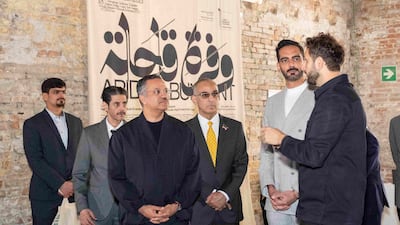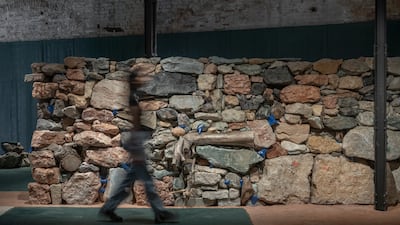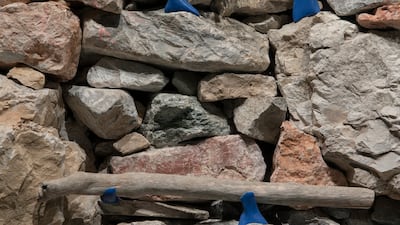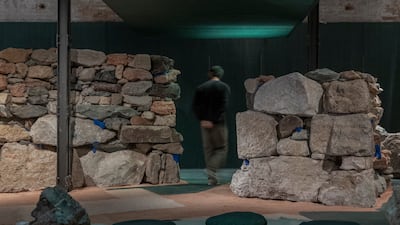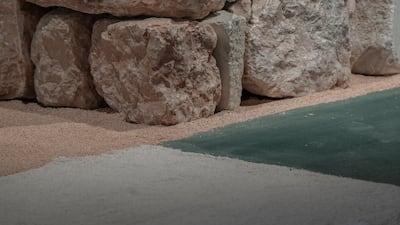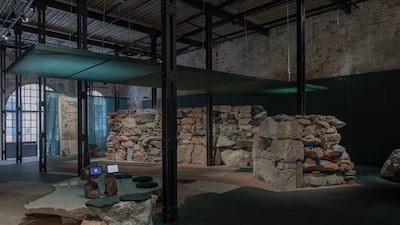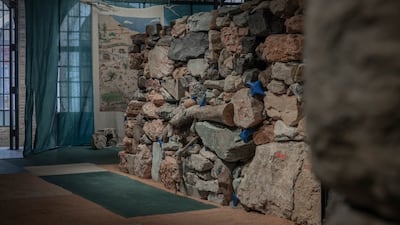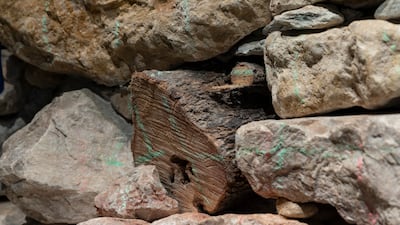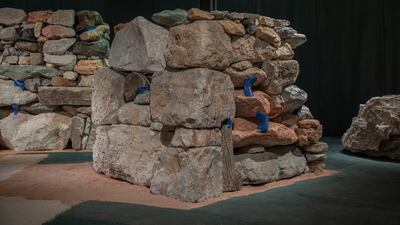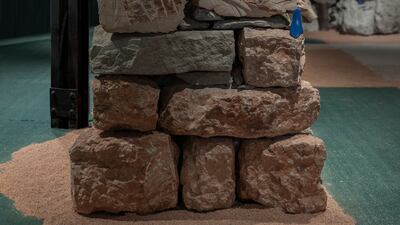The National Pavilion UAE marks its fifth participation at Venice's Biennale Architettura with an exhibition that seeks to upend the assumption that arid landscapes are barren and scarce in resources.
As climate conditions exacerbate challenges of aridity around the globe, Aridly Abundant highlights practices that have successfully supported life in water-scarce environments, suggesting how can they be adapted to other contexts to relieve the strain on natural resources.
The exhibition takes its cue from traditional regional practices, showing how they can inspire contemporary solutions to global environmental problems. It highlights areas in the UAE, specifically the desert plateau, wadis and coastal plains in and around Al Hajar Mountains, as well as their thriving but misunderstood ecosystems.
Aridly Abundant was inaugurated by Salem Al Qassimi, the UAE Minister of Culture and Youth. The exhibition will be on view until November 26 at the National Pavilion UAE’s permanent space at La Biennale di Venezia’s Arsenale — Sale d’Armi. A virtual tour of the exhibition is also available on the National Pavilion UAE website.
Al Qassimi said: “Our participation in this prestigious global platform is a reflection of our country's cultural and social status and its rich artistic heritage. The works of UAE’s home-grown talent exhibited at the National Pavilion have contributed to the growth of the National Pavilion in the biennales over the past 12 years. The UAE’s talent has been adding much value to the Pavilion in recent years.
He added: “We are delighted by the achievements of the National Pavilion, which reflect the creative scene in our country and demonstrate how art from the UAE is being noticed and appreciated by artists and culture bearers from around the world, acting as a bridge from the UAE to other cultures worldwide.”
The exhibition is curated by Faysal Tabbarah, an associate professor of architecture at the American University of Sharjah. Tabbarah was chosen as this year’s curator through an open call issued by the National Pavilion UAE. His curatorial research team consists of AUS alumni. The team also includes three interns from National Pavilion UAE’s Venice Internship programme.
The UAE government’s declaration of 2023 as the Year of Sustainability, coupled with the imminent United Nations Climate Change Conference – set to take place in Dubai on November – presented an opportunity for Tabbarah to focus on how architecture can respond to environmental concerns.
“The UAE has been a supportive environment for innovation and with Cop28 coming up, it gave me the perfect opportunity to work on an ambitious project focusing on architectural provocations that can have real-life applications in response to climate change,” he says.
“One of the central ideas in the exhibition is that the answer to issues arising from climate change doesn’t lie solely in contemporary technology but we must combine it with traditional and historical knowledge in order to make progress,” he adds. “For example, UAE’s land-based practices were derived from and adapted to water-scarce environments and are suitable for countries now facing the risk of desertification once integrated with modern technology.”
Aridly Abundant
By examining the tactics as well as materials inherent to the region, Tabbarah provokes a discussion on a future that makes the most of natural resources while slowing the degradation of land.
“Reusing materials also decreases energy consumption, helping relieve the strain on natural resources,” he says. “The discarded stone fragments we used were originally destined to be ground to a powder to be then used for other purposes – which uses a lot of energy – but by intervening, we proposed ways in which they can be repurposed for architectural use.”
Aridly Abundant transforms the National Pavilion UAE into an elegy of the spatial, material, and tactile qualities of arid landscapes. A series of stone assemblies are inserted into the space to exhibit the multitude of assembly tactics identified in Al Hajar such as dry-stacking, tethering and blurring.
“I identified these tactics of assembly during my research and exploration of UAE’s land-based practices in the Al Hajar Mountains,” Tabbarah says. “These were intuitive techniques developed over time by a community who understood and cherished the specificities of their land. These practices depended on as well as supported the thriving ecosystem particular to their water-scarce environment in a way that relieved the strain on natural resources and exhibited care for their land.”
Audiovisual vignettes by commissioned-artist Reem Falaknaz, an AUS alumnus, allow visitors to experience the environment of Al Hajar. Falaknaz is also presenting a series of photographs taken during her travels to the mountains.
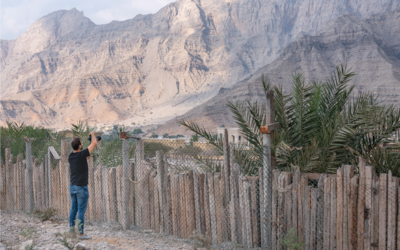
Furthermore, the exhibition includes a large-scale drawing of the landscape and material culture of Al Hajar, telling eight stories about the highlighted tactics to ground the exhibition in the context of the UAE. The drawing acts as the connective tissue emphasising the relationship between the stone assemblies in the space and Falaknaz's vignettes.
In order to demonstrate that the tactics found in the UAE can be translated and employed in other contexts, the assembly methods have been applied to discarded stone fragments from quarries within the Veneto region of Italy. Infused with technologies such as 3D scanning and 3D printing that facilitate design and assembly, the stone devices suggest contemporary and alternative building systems rooted in their cultural and material environments.
Tabbarah says: “My research is meant to benefit any and all regions that face the risk of aridity so a key aim is to prove the adaptability of the methods I am proposing.”
“Using materials sourced from the region as well as creating the exhibition elements on ground in Venice helped me demonstrate the feasibility of my research and how it can be adapted to the environment it is applied in, showing that integrating land-based practices with technology can be a long-term and sustainable method to respond to climate change from within the construction industry.”
In Plain Sight
An accompanying publication, In Plain Sight: Scenes from Aridly Abundant Landscapes is also being released at the exhibition. Conceived as a travelogue, the book is published by Kaph Books and challenges preconceptions around aridity. It is co-edited by Tabbarah and Meitha Almazrooei, another AUS alumnus.
“Travelogues, as a genre of writing, are malleable and as such allow for a less structural approach,” Almazrooei says. “Conceptually, the essays are then able to take on a pace that stretches and intricate language around observations begin to appear.
“Abundance in architecture is often thought of as an abundance of particular resources. Here, we look at abundance in language, descriptions, building materials, and the knowledge of people who have been generous enough to share their experiences with the writers in the book. An abundance in a way of seeing the extended environment.”
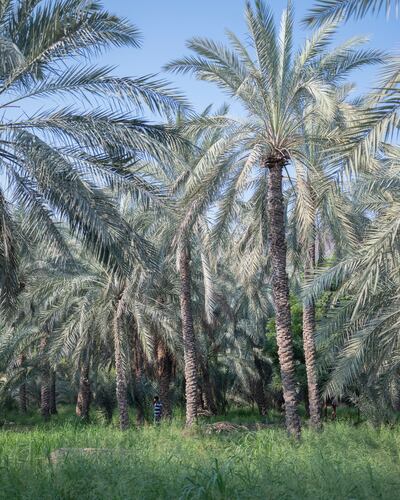
The writings, Almazrooei says, act as vignettes that evoke the sensations and textures of moving through an arid landscape.
“Additionally, the first-person narrative frames the perceptions shared as those of individuals, steering away from the popular generalizations made when writing a broader history.”
National Pavilion UAE
Aridly Abundant marks the National Pavilion UAE’s fifth year of participation in the international architecture exhibition at the Venice Biennale. The country, however, is celebrating its 12th participation at the biennale. The National Pavilion UAE is commissioned by the Salama bint Hamdan Al Nahyan Foundation and supported by the Ministry of Culture and Youth.
“We are pleased to see the National Pavilion UAE sharing local knowledge and research to collectively co-create sustainable solutions for the future,” said Angela Migally, executive director of the foundation. “The National Pavilion UAE has been a long-standing platform for the UAE to effectively showcase our knowledge and creativity to the world for the past 12 years, allowing us to impactfully participate in ongoing global discourse.”
Laila Binbrek, the pavilion’s director, says the theme for this year’s exhibition coincides neatly with the sustainability initiatives the country has recently rolled out.
“In recent years, the UAE has made immense strides in supporting sustainability initiatives and has become the first country in the Mena region to pledge its commitment to reach net zero emissions by 2050,” she says.
“As the search for alternative approaches to respond to the global climate change intensifies, the National Pavilion UAE plays a crucial role in their development as we provide a platform for thought leaders to experiment by encouraging them to draw inspiration from the UAE’s geography, history, and traditions.”
Binbrek says Tabbarah “offers a series of provocations on how we can reuse waste materials to investigate a method to reduce the ongoing negative impact of the construction industry on the environment”.
“Construction, as a carbon-heavy sector, has exacerbated the effects of global warming and with urban development on the rise, it is crucial to counter these problems with long-term sustainable techniques. The exhibition showcased at the pavilion is UAE’s response to the issue.”
